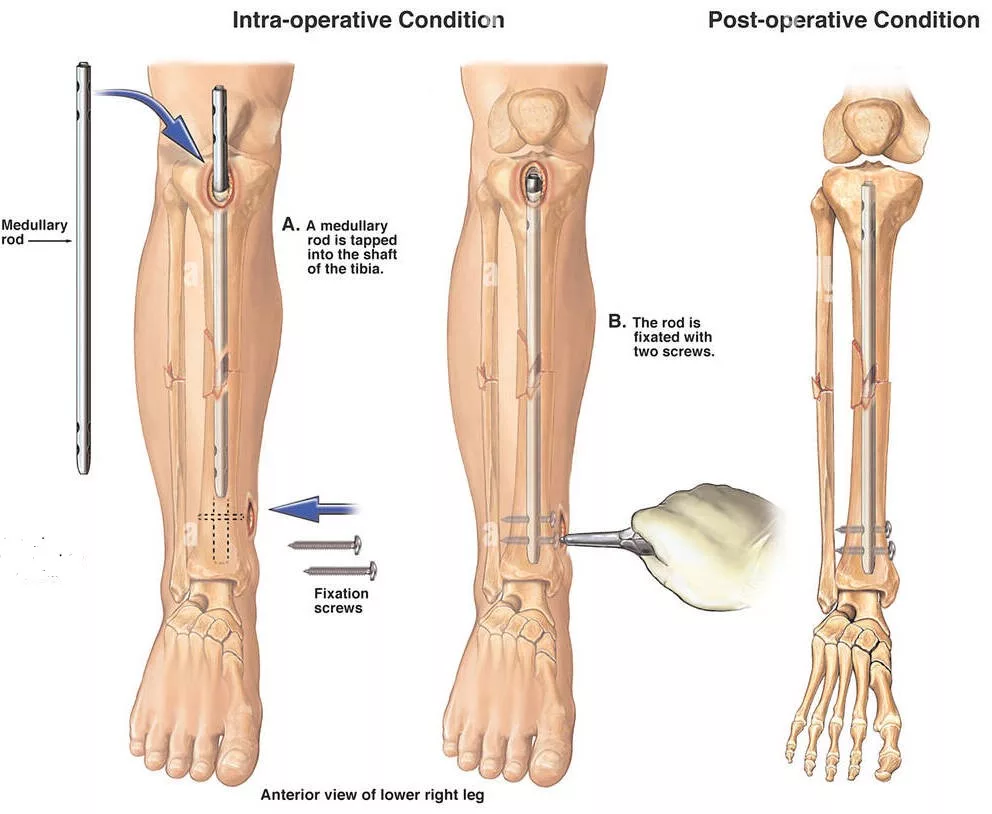 Tibia fractures are serious injuries that can majorly affect a person’s mobility and general health. An effective healing process requires accurate diagnosis, treatment, and recovery. We will delve into tibia fractures in this detailed guide, focusing on the healing and diagnosing process, emphasizing tibia nail fractures.
Tibia fractures are serious injuries that can majorly affect a person’s mobility and general health. An effective healing process requires accurate diagnosis, treatment, and recovery. We will delve into tibia fractures in this detailed guide, focusing on the healing and diagnosing process, emphasizing tibia nail fractures.
Tibia Fractures Healing & Diagnosis
Tibia fractures are diagnosed through a complete evaluation incorporating physical examination, medical history review, and imaging modalities. The first step is a full physical exam in which the healthcare provider looks for evidence of discomfort, edema, deformity, or an open wound in the affected area. They will also question the incident’s circumstances to understand the fracture process better.
Process of Classification and Healing
The AO/OTA classification method can classify tibia fractures based on location, severity, and parallel soft tissue damage. This classification assists healthcare providers in determining the best treatment option for each patient.
Tibia fracture healing consists of several stages,
-> inflammatory
-> repair
-> remodeling
Tibia Nail Fractures
Tibia nail fractures are forms of fractures that occur when tibia nails or intramedullary nails are present. These nails are routinely used to support the bone and help with normal healing in the surgical treatment of tibia fractures. Patients and healthcare professionals involved in fracture management must understand the characteristics, surgical methods, and potential problems related to tibia nail fractures.
Surgical Procedure for Tibia Nail Insertion
The surgical method for installing tibia nails is difficult and requires the skill of an orthopedic physician.
Pre-operative Diagnosis and Planning
Before planning the surgical procedure, the surgeon studies the fracture pattern and the patient’s overall health.
Incision and anesthesia
The patient is unconscious, and a cut is made over the tibia to gain access to the medullary canal.
Insertion and Alignment of Nails
The tibia nail is advanced to the desired position after being introduced into the medullary canal. Imaging guiding and complex instruments are used to obtain precise alignment.
Post-operative Care and Closure
Sutures or staples are used to close the incision, and the patient is given post-operative instructions that include pain management, weight-bearing restrictions, and rehabilitation activities.
Tibia Nail Manufacturer & Supplier
The production and distribution of tibia nails are critical in giving healthcare providers the tools they need for optimal fracture therapy. Choosing a reputable manufacturer and supplier is critical to ensure the quality, innovation, and timely availability of tibia nails.
Importance of Choosing a Reliable Manufacturer
It is critical to choose a reputed manufacturer for tibia nails for the following reasons:
Quality Control and Compliance
A reputable producer follows strong quality control procedures and follows international standards and laws. It guarantees that the tibia nails manufactured satisfy the needed criteria, are safe to use, and work optimally.
Technological Advancements and Innovation
Established manufacturers spend on research and development to continuously improve their products. They use modern manufacturing techniques, materials, and design advances to improve tibia nail functionality, durability, and patient results.
Customer Reputation and Feedback
A reliable manufacturer builds a solid reputation in the medical community by consistently delivering high-quality products. They have a track record of providing excellent customer service and have received favorable comments from healthcare professionals using their tibia nails.
Tibia Nail Exporter
A tibia nail exporter is a business that specializes in the distribution and export of tibia nails to various locations and marketplaces throughout the world. Because tibia nails are extensively used in the surgical treatment of tibia fractures, exporters play an important role in ensuring that these medical devices are available and accessible to healthcare professionals and facilities worldwide.
Importance of Tibia Nail Exporters
Access to High-Quality Products Around the World
Exporters make it possible for healthcare professionals and facilities in other nations to obtain high-quality tibia nails. They operate as an interface between manufacturers and end-users, ensuring medical practitioners access the most sophisticated tibia nail products on the market.
Market Reach and Expansion
Exporters are important in broadening the market reach of tibia nails. They help healthcare providers to deliver appropriate fracture management alternatives to their patients by exporting these items to various locations and countries.
Regulatory Compliance
A reputable tibia nail exporter is aware of and follows the regulatory requirements of various nations or areas. They verify that the exported tibia nails meet all certifications, regulations, and recommendations, ensuring patient safety and regulatory compliance in the importing nations.
Supply Chain Efficiency
Exporters optimize the supply chain process, ensuring that tibia nails arrive at their destinations on time and in good condition. They handle logistics, customs processes, and transportation, ensuring that supplies are delivered safely and on schedule to healthcare institutions.
Conclusion
Navigating the path from diagnosis to healing in tibia fractures requires a thorough awareness of the diagnosis process, treatment options, and proper recovery care. Tibia fractures can substantially impact an individual’s mobility and overall well-being, but successful healing is possible with the appropriate approach and direction.

